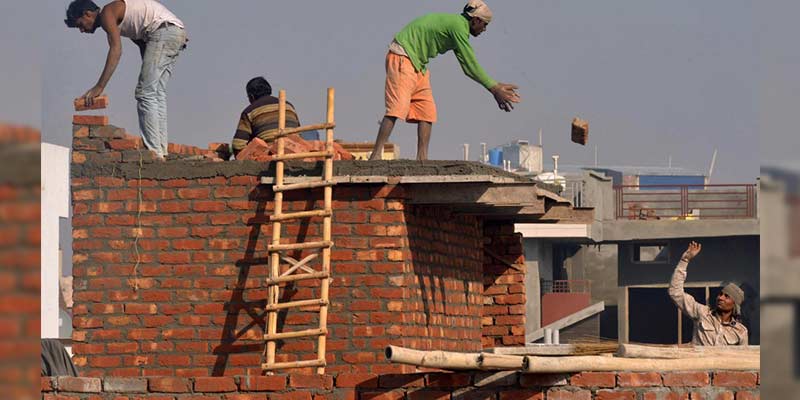- India
- Jun 29
Explainer / PM Awaas Yojana
The Union government has sanctioned more than 2.5 lakh more affordable houses in 10 states under the Pradhan Mantri Awas Yojana (Urban). According to the housing and urban affairs ministry, the total number of houses being funded under the PMAY (Urban) is close to 84 lakh across the country so far.
The approval was given in a meeting of the central sanctioning and monitoring committee (CSMC) chaired by ministry secretary Durga Shanker Mishra. According to him, out of 84 lakh houses sanctioned so far, Uttar Pradesh is the biggest beneficiary with 13 lakh houses, followed by Andhra Pradesh with more than 12 lakh houses.
Earlier this week, Union Housing and Urban Affairs Minister Hardeep Singh Puri had said that the target of constructing 1 crore houses under the PMAY (Urban) can be achieved by 2020-end, two years before the deadline.
Pradhan Mantri Awas Yojana is an initiative by the government in which affordable housing will be provided to the poor with a target of building 20 million affordable houses by 31 March 2022. It has two components: Pradhan Mantri Awas Yojana (Urban) for the urban poor and Pradhan Mantri Awaas Yojana (Gramin) for the rural poor.
Pradhan Mantri Awaas Yojana (Gramin)
The rural housing programme started with Indira Awaas Yojana (IAY) in January 1996. However, certain gaps were identified during the concurrent evaluations and the performance audit by the Comptroller and Auditor General (CAG) of India in 2014.
To address these gaps in the rural housing programme and in view of the government’s commitment to providing housing for all by the scheme, the IAY was restructured into the Pradhan Mantri Awaas Yojana - Gramin (PMAY-G) from April 1, 2016.
PMAY-G aims at providing a pucca house with basic amenities to houseless people and those households living in kutcha and dilapidated house by 2022. The immediate objective is to cover 1 crore households living in kutcha house/dilapidated houses in three years from 2016-17 to 2018-19. The minimum size of the house has been increased to 25 sq m (from 20 sq m) with a hygienic cooking space.
In PMAY-G, programme implementation and monitoring is to be carried out through an end-to-end e-Governance model using AwaasSoft and Awaas App.
Pradhan Mantri Awas Yojana (Urban)
The PMAY (U), launched by Prime Minister Narendra Modi in June 2015, aims at ensuring housing for all by 2022 by providing financial assistance to beneficiaries.
The government has set a target of 1 crore houses in urban areas across the country over a period of seven years from 2015 to 2022.
At the slum decadal growth rate of 34 per cent, the slum households are projected to go up to 18 million. Two million non-slum urban poor households are proposed to be covered under the mission. Hence, total housing shortage envisaged to be addressed through the new mission is 20 million.
The mission will be implemented as a centrally sponsored scheme except for the component of credit-linked subsidy, which will be implemented as a central sector scheme.
The mission will support the construction of houses up to 30 sq m carpet area with basic civic infrastructure.
It provides central assistance to urban local bodies (ULBs) and other implementing agencies through states/UTs for…
* Rehabilitation of slum-dwellers with participation of private developers using land as a resource
* Promotion of affordable housing for weaker sections through credit-linked subsidy
* Affordable housing in partnership with public and private sectors
* Subsidy for beneficiary-led individual house construction
In the spirit of cooperative federalism, the mission provides flexibility to states for choosing the best options among four verticals of mission to meet the demand for housing.
The process of project formulation and approval in accordance with the mission guidelines has been left to the states so that projects can be formulated, approved and implemented faster.
A technology sub-mission is set up to facilitate the adoption of modern, innovative and green technologies and building material for faster and quality construction of houses. The sub-mission also facilitates the preparation and adoption of layout designs and building plans suitable for various geo-climatic zones. It will also assist states/cities in deploying disaster resistant and environment friendly technologies.
Three phases of PMAY envisage starting and completing construction work as follows…
Phase 1 from April 2015 to March 2017 to cover 100 cities.
Phase 2 from April 2017 to March 2019 to cover an additional 200 cities.
Phase 3 from April 2019 to March 2022 to cover the remaining cities.

